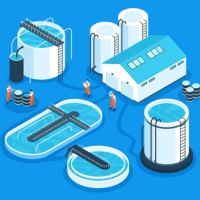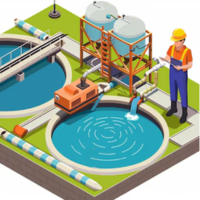What is a Water Treatment Plant?
A Water Treatment Plant (WTP) is an industrial facility designed to remove contaminants from raw water sourced from rivers, lakes, groundwater, or wastewater, ensuring it is safe for drinking, industrial use, agriculture, or environmental discharge. It utilizes a combination of physical, chemical, and biological methods to purify water effectively.

Why Choose a Water Treatment Plant in Chennai?
Water treatment plants are essential for public health, environmental protection, and economic activities by:
Promoting water sustainability and enabling reuse
Ensuring compliance with stringent regulatory standards set by bodies like the EPA and WHO
Supporting industrial processes and agricultural irrigation
Removing harmful contaminants including bacteria, heavy metals, and chemicals
Preventing waterborne diseases such as cholera and dysentery
Types of Water Treatment Plants
Municipal Water Treatment Plants
Provide clean, potable water to residential and commercial areas

Wastewater Treatment Plants (WWTP)
Process domestic sewage and industrial effluents to prevent pollution

Portable Water Treatment Units
Deployable solutions for emergency or remote location water purification

Industrial Water Treatment Plants
Tailored for specific industrial processes, including cooling, manufacturing, and chemical industries
Desalination Plants
Convert seawater or brackish water into freshwater using technologies like reverse osmosis
How Does a Water Treatment Plant Work?
Screening – Large debris (such as leaves, branches, trash) is physically removed
Coagulation & Flocculation – Chemicals like alum or ferric chloride clump fine particles together, forming larger particles called floc
Sedimentation – Gravity causes floc and other heavy particles to settle at the bottom of settling tanks
Filtration – Water passes through layers of sand, activated carbon, or specialized membranes to trap finer impurities
Disinfection – Chlorination, UV light, or ozonation kill pathogenic microorganisms
Storage & Distribution – Treated water is stored in reservoirs or tanks and distributed through pipes to consumers
Key Components of Water Treatment Plants
Filters: Sand, activated carbon, and membrane filters for removing fine particles
Clarifiers: Settling tanks that help remove sediment
Chemical dosing systems: Precise injection of chemicals for coagulation, disinfection, and pH adjustment
Pumps and valves: Essential for moving water, controlling flows, and managing treatment processes
Storage tanks: Reservoirs to store treated water safely

Water Treatment Processes

Biological Processes
- Activated Sludge: Bacteria decompose organic pollutants
- Trickling Filters: Biofilms on media break down contaminants as water trickles through

Physical Processes
- Screening: Removal of large solids
- Sedimentation: Natural settling of suspended particles
- Filtration: Trapping smaller impurities using various media

Chemical Processes
- Using chemicals to clump small particles into larger ones for easier removal
- Elimination of pathogens using chlorine, ultraviolet light, or ozone
- Balancing water acidity or alkalinity to prevent corrosion or scaling
Water Treatment Processes
Standards: Guidelines set by the EPA (US), WHO, and local agencies
Contaminants: Includes bacteria, heavy metals, pesticides, pharmaceuticals
Testing Methods: Commonly tested parameters include turbidity, pH levels, Biological Oxygen Demand (BOD), and Chemical Oxygen Demand (COD)
Equipment & Technology
Pumps & Valves: Used for fluid transportation and control within the treatment process
Reverse Osmosis (RO): Advanced filtration for desalination and purification
Ultrafiltration (UF) & Nanofiltration (NF): Removing microscopic particles and pathogens
SCADA Systems: Automation systems for real-time monitoring and control of treatment processes
Maintenance & Operations
Routine inspections and daily operational checklists
Common troubleshooting scenarios like equipment failures or water quality fluctuations
Scheduled preventive maintenance practices to ensure reliable plant operation
Frequently Asked Questions
What are the 3 types of water treatment plant?
Types of Water Treatment Plants :
- Wastewater Treatment Plant (WWTP)
- Sewage Treatment Plants (STPs)
- Effluent Treatment Plants (ETP’s)
- Demineralization (DM) Treatment Plants.
- Reverse Osmosis (RO) Water Treatment.
What does a water treatment plant operator do?
Water treatment plant and system operators run the equipment, control the processes, and monitor the plants that treat water to make it safe to drink. Wastewater treatment plant and system operators remove pollutants from domestic and industrial waste.
What type of industry is water treatment?
The water industry includes water engineering, operations, water and wastewater plant construction, equipment supply and specialist water treatment chemicals, among others. The water industry is at the service of other industries, e.g. of the food sector which produces beverages such as bottled water.
What is the water treatment process?
They typically consist of several steps in the treatment process. These include: (1) Collection ; (2) Screening and Straining ; (3) Chemical Addition ; (4) Coagulation and Flocculation ; (5) Sedimentation and Clarification ; (6) Filtration ; (7) Disinfection ; (8) Storage ; (9) and finally Distribution.
What are the benefits of water treatment?
- Provides Clean and Reusable Water. This is obvious that throwing away even wastewater is harmful to nature.
- Protect Environment. Wastewater contains a lot of waste materials including chemical components.
- Keeps Disease Away.
- Strengthens Economy.
- Produces Energy
